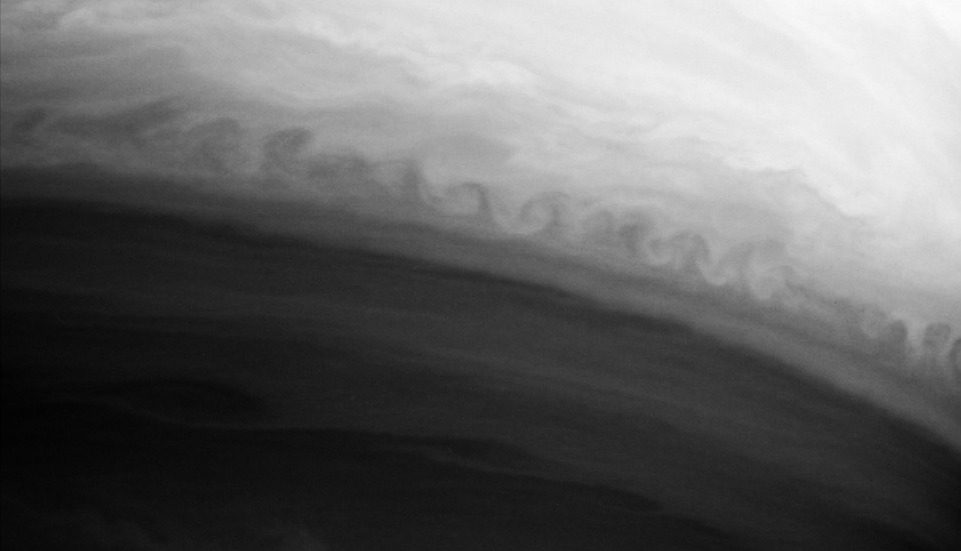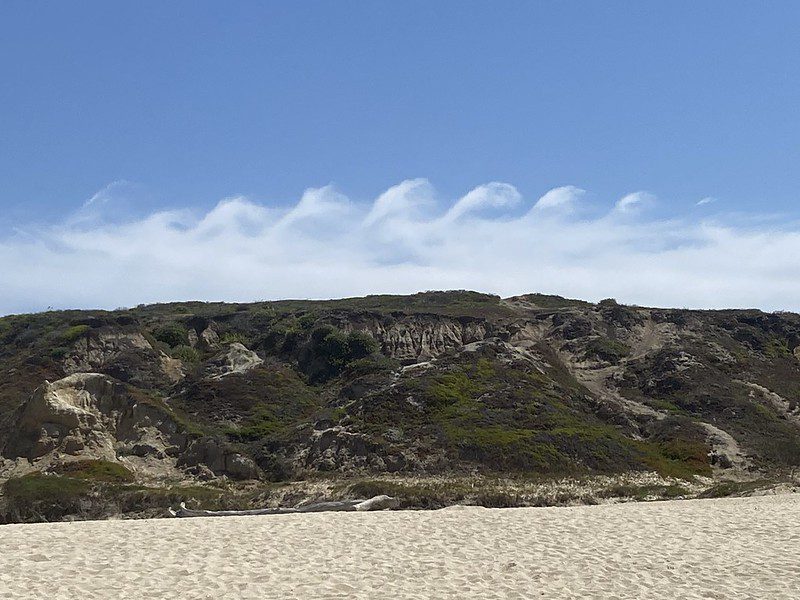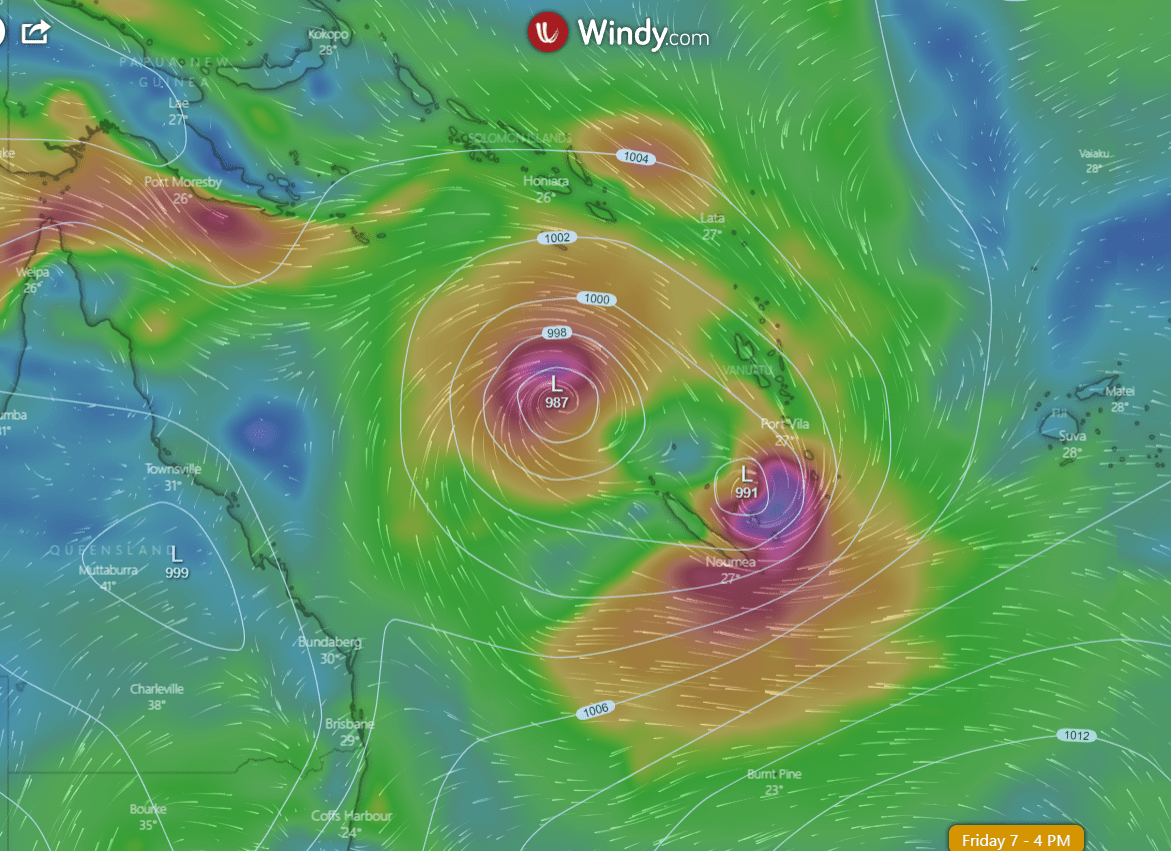Kelvin-Helmholtz waves, also known as KH waves, are a fascinating phenomenon that occurs in fluid dynamics. These waves are the result of an instability that arises between two fluids moving at different speeds, such as air and water, or two layers of air with different velocities.
Understanding the science behind these waves can help us gain valuable insights into the behavior of fluids and turbulence and their impact on the environment and human life. In this article, we will explore the science of Kelvin-Helmholtz waves in detail, demystifying the complex concepts and equations that govern their behavior.
We will delve into the different types of KH waves, their characteristics, and the role of viscosity in Kelvin-Helmholtz instability. Additionally, we will discuss the significance of studying these waves and how they can help us better understand the world around us.
So, join us on this journey into the fascinating world of Kelvin-Helmholtz waves, and discover the secrets of one of the most intriguing phenomena in fluid dynamics.
What are Kelvin-Helmholtz Waves?
Kelvin-Helmholtz waves are a type of instability that occurs at the boundary between fluids of different densities and velocities. They arise due to the presence of a shear layer, where there is a significant velocity difference between the two fluids. This shear layer generates turbulence, which in turn creates vortices that roll up into waves.
The waves themselves are characterized by their distinctive shape, which resembles a series of crests and troughs. These waves play an important role in many natural systems, including the Earth’s atmosphere and oceans, as well as in engineering applications such as aircraft design and weather forecasting.
Understanding the physics of Kelvin-Helmholtz waves is therefore crucial for a wide range of fields, and ongoing research continues to shed new light on this complex and fascinating phenomenon.
How Did These Clouds Get Their Name?
Kelvin-Helmholtz Clouds were named after the scientists that discovered and documented them—namely Lord Kelvin and Hermann von Helmholtz.


Understanding Kelvin-Helmholtz Instability
The phenomenon of fluid instability arising from the velocity difference between two fluids with a sharp boundary has been subject to extensive research in the field of fluid dynamics.
The Kelvin-Helmholtz instability, also known as KH instability, is a common type of instability that occurs when two fluids with different velocities are in contact, leading to the formation of Kelvin-Helmholtz waves.
This instability is particularly relevant in the context of Kelvin-Helmholtz clouds, which are often observed in the atmosphere and can lead to turbulence and mixing of the fluids.
Understanding the underlying physics of this instability is crucial for predicting and mitigating its effects.
Some key factors that contribute to Kelvin-Helmholtz’s instability include the magnitude of the velocity difference between the fluids, the shear rate, the density difference, and the viscosity of the fluids.
Further research is needed to fully understand the mechanisms at play in this fascinating phenomenon.
See the Video of the Numerical simulation of a temporal Kelvin–Helmholtz instability.
The Role of Turbulence in KHI
Turbulence plays a critical role in the understanding and prediction of fluid instability arising from velocity differences between two fluids, such as in the case of Kelvin-Helmholtz waves and Helmholtz instability.
The presence of turbulence can significantly affect the development and evolution of these instabilities, as it can provide the necessary energy for the growth of the perturbations while also increasing the rate of mixing between the two fluids.
The shear between the fluids is a key factor in inducing turbulence, and the resulting chaotic flow patterns can lead to the formation of vortices and eddies, which can further promote the growth of the instability.
The study of turbulence in KHI is, therefore, crucial for improving our understanding of fluid dynamics and for developing more accurate models for predicting the behavior of these waves and their potential impact on various natural and engineered systems.

Types of Kelvin-Helmholtz Waves
Kelvin-Helmholtz waves are a type of fluid instability that occurs at the interface of two fluids with different velocities. These waves are observed in a variety of settings, including the atmosphere, oceans, and even in space.
In the atmosphere, Kelvin-Helmholtz waves can result in the formation of clouds and turbulence, while in the ocean, they can cause mixing and nutrient transport. Similarly, in the context of astrophysics, Kelvin-Helmholtz waves are important for understanding the dynamics of stars and other celestial bodies.
Atmospheric Kelvin-Helmholtz Waves
Atmospheric instabilities can give rise to complex wave patterns that are similar in appearance to Kelvin-Helmholtz waves observed in other fluid systems.
These atmospheric Kelvin-Helmholtz waves are a type of weather phenomenon that occurs in the upper layer of air, where two layers of air with different velocities come into contact.
The resulting instability can create stunning Kelvin-Helmholtz clouds, which are characterized by their wavy, rolling appearance.
While these clouds may be visually striking, they can also be indicative of dangerous weather conditions, such as turbulence and wind shear.
Kelvin-Helmholtz’s instabilities are a fascinating area of study for atmospheric scientists, as they can provide insight into the complex dynamics of the atmosphere and help us better understand the forces that shape our planet.
Oceanic Kelvin-Helmholtz Waves
The study of oceanic instabilities can reveal new insights into the complex behavior of fluid dynamics in the world’s oceans.
Oceanic Kelvin-Helmholtz waves are a type of instability that occurs in regions of velocity shear, where there is a difference in the speed or direction of ocean currents.
These waves are similar to atmospheric Kelvin-Helmholtz clouds, but they occur in the ocean instead of the atmosphere.
The instability arises when the velocity shear exceeds a critical threshold, causing the water to break into a series of vortices.
These vortices can be seen as undulating, rolling waves on the surface of the ocean.
The study of oceanic Kelvin-Helmholtz waves is important because it can provide insights into the dynamics of ocean currents and the mixing of different water masses.
Understanding these dynamics is crucial for predicting the behavior of the ocean and its influence on climate.

Solar Kelvin-Helmholtz Waves
Moving from oceanic to solar Kelvin-Helmholtz waves, these waves have been observed at the interface of the solar wind and the interstellar medium.
These waves are believed to be driven by the viscosity of the plasma at the interface, as well as the presence of a magnetic field.
Studies have shown that these waves can create wave clouds, which are visible features in the solar wind and can affect the transport of plasma and magnetic fields throughout the heliosphere.
Understanding the behavior of these waves is crucial in predicting space weather events and their impact on Earth.
Stellar Kelvin-Helmholtz Waves
Stellar Kelvin-Helmholtz waves are observed at the boundary of differentially rotating stars and are believed to play a key role in the transport of angular momentum and the redistribution of chemical elements throughout the star.
These waves form due to the wind shear that occurs at the interface between the upper layer and the lower layer of a star.
The Kelvin-Helmholtz cloud formation occurs when the velocity difference between the two layers exceeds the threshold value.
This phenomenon is responsible for the turbulent mixing of the star’s material, which can carry elements from the core to the surface and vice versa.
The study of these waves is crucial in understanding the physical mechanisms that govern the evolution of stars.
Recent observations suggest that these waves may also contribute to the formation of magnetic fields in stars.
Further research in this field may lead to new insights into the formation and evolution of stars.
KH Wave Characteristics
Evidently, the distinguishing feature of Kelvin-Helmholtz waves is the presence of a shear layer between two fluids with different velocities. This leads to the formation of wave-like patterns that are characterized by several unique characteristics.
Firstly, Kelvin-Helmholtz waves can occur in a wide range of environments, from the atmosphere to the ocean and even in the interstellar medium.
Secondly, these waves have been observed to occur in the form of vortices, clouds, and even in the form of a Kelvin cloud.
Thirdly, the amplitude of these waves is proportional to the shear velocity, and the wavelength is inversely proportional to the shear layer thickness.
Fourthly, Kelvin-Helmholtz waves can lead to the formation of Kelvin-Helmholtz instabilities (KHI), which can result in the mixing of fluids.
Lastly, the presence of a temperature inversion can enhance the formation of these waves, as it can create a stable layer that can trap the wave energy and lead to the formation of larger Kelvin-Helmholtz vortices.
Understanding these characteristics is essential in demystifying the science of Kelvin-Helmholtz waves and their role in various natural phenomena.

KH Wave Formation
One crucial aspect of understanding Kelvin-Helmholtz wave phenomena is comprehending the mechanisms by which these waves are formed. These waves are a result of the interaction between two fluids of different densities and velocities, such as air and water, or two layers of air with different wind speeds.
The formation of KH waves can be explained by the Kelvin-Helmholtz instability, which occurs when there is a shear flow between two fluids with different velocities. This instability causes the development of vortices, or eddies, that grow and evolve into the classic “billow clouds” associated with KH waves.
The instability is named after Lord Kelvin and Hermann von Helmholtz, who independently proposed the mechanism in the late 1800s. To further emphasize this point, the following table outlines the key characteristics of the Kelvin-Helmholtz instability and how it relates to KH wave formation:
| Mechanism | Description |
|---|---|
| Shear flow | Two fluids with different velocities |
| Kelvin-Helmholtz instability | Instability due to shear flow |
| Vortices | Eddies that develop and grow |
| Billow clouds | The classic appearance of KH waves |
| Wind speed | Determines the strength and size of KH waves |
Understanding the formation of KH waves is essential for predicting and modeling their behavior, which is important for a range of applications, including aviation and weather forecasting. By understanding the underlying science of KH waves, researchers can develop better models and simulations that accurately predict the behavior of these fascinating phenomena.
KH Wave Dynamics
The behavior and dynamics of Kelvin-Helmholtz waves are influenced by a variety of factors, including the velocity and density of the fluids involved, as well as the size and strength of the vortices that develop. As a result, the dynamics of these waves are complex and can vary widely depending on the specific circumstances.
For example, Lord Kelvin and Hermann von Helmholtz demonstrated that these waves are affected by surface tension, which can cause the fluid interface to become unstable and form waves. Additionally, wave number plays a significant role in the behavior of KH waves, as it determines the wavelength of the waves and how they interact with other fluid structures.
Overall, understanding KH wave dynamics is critical for predicting and modeling the behavior of fluids in a variety of settings, including atmospheric and oceanic systems. As such, ongoing research in this area is of great importance to the scientific community and promises to yield valuable insights into the fundamental nature of fluid dynamics.
KH Wave Interactions
Interactions between Kelvin-Helmholtz waves and other fluid structures play a crucial role in the behavior and dynamics of fluids in various natural systems. In particular, these waves are known to interact with shear gravity clouds, which are observed on both Saturn and Jupiter.

These interactions can lead to the formation of a phenomenon known as Fluctus, which are large-scale wave-like structures that are thought to be caused by the interaction between different densities of fluid.
In a recent study, researchers investigated the behavior of Kelvin-Helmholtz waves as they interacted with shear gravity clouds in laboratory experiments. The study found that the interaction between these two fluid structures can lead to the formation of complex wave patterns, which can be difficult to predict using traditional fluid dynamics models.
These findings have important implications for our understanding of the dynamics of fluids in natural systems and could help improve our ability to predict the behavior of these systems in the future.
KH Wave Amplification
Amplification of Kelvin-Helmholtz waves has been extensively studied in the context of fluid dynamics and has important implications for the behavior of fluids in various natural systems.
KH wave amplification occurs when the velocity shear between two fluids with different densities generates instability, leading to the formation of fluctus and eddies.
These eddies can amplify the KH waves by extracting energy from the stable layer and transferring it to the unstable layer.
The amount of amplification depends on the amplitude and wavelength of the initial KH waves, as well as the density and viscosity of the fluids involved.
Studies have shown that KH wave amplification can occur in a variety of natural systems, including the atmosphere, oceans, and even in laboratory experiments.
Understanding the mechanisms behind KH wave amplification is crucial for predicting and explaining fluid behavior in these systems.
KH Wave Instability
After discussing KH wave amplification, we will now delve into the topic of KH wave instability.
The Kelvin-Helmholtz waves are generated due to the shear between two fluids moving at different velocities, and this shear leads to instability in the fluid, which results in the formation of KH waves.
The instability occurs when the shear is strong enough to overcome the viscous forces in the fluid.

The KH wave instability is an important phenomenon in astrophysics, as it is the driving force behind the formation of structures such as the spiral arms in galaxies and the plasma filaments in the solar wind.
Understanding the intricacies of the KH wave instability is essential for scientists to comprehend the behavior of fluids in various physical systems.
By studying the properties of the instability, researchers can gain insights into the underlying physics of fluid dynamics and develop more accurate models to predict the behavior of fluids in different environments.
KH Wave Propagation
The propagation of Kelvin-Helmholtz waves is a crucial aspect of understanding the behavior of fluids in various physical systems. These waves occur when there is a difference in speed between two fluids or layers within a single continuous fluid. The shear-gravity clouds that are formed due to differences in fluid velocity create instability that leads to the formation of the KH waves.
The propagation of these waves is characterized by the formation of vortices along the interface of the two fluid layers. The velocity and amplitude of the waves depend on the difference in speed between the fluids and the thickness of the interface. Understanding the propagation of KH waves is important in various fields, such as atmospheric science, oceanography, and astrophysics, where these waves are frequently observed.
KH Wave Dissipation
One important aspect to consider in the study of Kelvin-Helmholtz (KH) wave propagation is the dissipation of these waves, which can occur through several mechanisms.
These mechanisms include turbulence, viscous damping, thermal conduction, and radiative cooling.
KH waves are often observed in shear-gravity clouds on planets like Jupiter and Saturn, and understanding the dissipation of these waves can give insight into the behavior of these planetary atmospheres.
While KH waves can transport energy and momentum across the atmosphere, their dissipation can also lead to the mixing of different layers of the atmosphere and the transfer of heat and momentum, which can have a significant impact on atmospheric dynamics.
Viscosity and KHI
Viscosity plays a crucial role in the dynamics of Kelvin-Helmholtz instability (KHI), affecting the growth rate and development of the instability. KHI is a well-known phenomenon in fluid dynamics that occurs at the interface between two fluids with different velocities.
In the atmosphere, KHI can occur at the boundary of gravity clouds, where moisture and shear are present. Viscosity determines the dissipation rate of the energy transferred from the mean flow to the perturbations, and it also influences the length scale of the instability.
High viscosity leads to less dissipation and larger length scales, resulting in a slower instability growth rate. On the other hand, low viscosity leads to more dissipation and smaller length scales, resulting in a faster instability growth rate.
Understanding the role of viscosity in KHI is crucial in the study of fluid dynamics, and it has important implications in various fields, including meteorology, oceanography, and astrophysics.

The Science Behind KHI Waves
Understanding the dynamics of Kelvin-Helmholtz (KHI) waves is essential in studying the behavior of fluid systems at the interface between two fluids with different velocities.
These waves occur when there is a velocity difference between two fluids, causing a shear at the interface between them.
The science behind KHI waves involves the study of fluid mechanics and its associated equations, including Navier-Stokes and continuity equations.
These equations describe the behavior of fluids when subjected to different conditions, such as viscosity, pressure, and velocity.
The main characteristic of KHI waves is the formation of vortices that can lead to the mixing of the fluids.
The study of KHI waves has applications in various fields, including oceanography, aerodynamics, and astrophysics.
The demystification of KHI waves has led to a better understanding of fluid mechanics and the behavior of fluids at higher speeds.
June Phenomenon of KHI Waves
The June phenomenon of KHI waves is a captivating natural phenomenon that evokes a sense of awe and wonders in those who witness it.
It occurs when there is a significant difference in velocity between two adjacent fluids, resulting in the formation of KHI waves.
These waves are often observed in the atmosphere, particularly in the form of shear gravity clouds, where the change in velocity is caused by wind shear.
The June phenomenon is known for its unique occurrence during the summer solstice, where the Earth’s tilt causes a greater difference in temperature between the polar and equatorial regions, leading to stronger winds and greater wind shear.
By demystifying the science behind KHI waves, we can better understand and appreciate the beauty of this natural phenomenon.
Importance of Studying KHI Waves
After exploring the June Phenomenon of KHI Waves, it is now important to understand why studying these waves is significant.
KHI Waves are a natural phenomenon that occurs when there is a difference in wind speed at different levels of the atmosphere, such as on a windy day. This difference in wind speed causes the formation of billow clouds and cooler air at the top of an existing cloud layer.
By studying KHI Waves, we can gain insight into the dynamics of the atmosphere and how it affects weather patterns. Additionally, understanding KHI Waves can help us better predict severe weather events and improve aviation safety.
Overall, studying KHI Waves is essential in expanding our understanding of the atmosphere and its impact on our daily lives.

Frequently Asked Questions
How do Kelvin-Helmholtz waves affect ocean currents?
Kelvin-Helmholtz waves are known to cause turbulence in the surface layer of oceans, which can affect the mixing of water masses and alter current patterns. However, the exact extent of their impact on ocean currents remains unclear and requires further research.
Can Kelvin-Helmholtz waves be observed on other planets or celestial bodies?
Kelvin-Helmholtz waves have been observed on other planets and celestial bodies such as Jupiter, Saturn, and the sun. These waves play an important role in the dynamics of the atmospheres and ionospheres of these bodies and can provide valuable insights into their physical processes.
What is the relationship between Kelvin-Helmholtz waves and weather patterns?
Kelvin-Helmholtz waves are atmospheric phenomena that occur when there is a difference in wind velocity between two layers of air. They can affect weather patterns by causing turbulence, mixing air masses, and changing cloud formations.
Are there any potential benefits or applications of studying Kelvin-Helmholtz waves?
Studying kelvin-Helmholtz waves can lead to advancements in fields such as fluid dynamics and plasma physics. Understanding their behavior can also aid in predicting space weather and improving the design of aircraft and wind turbines.
How do scientists measure and track Kelvin-Helmholtz waves?
Kelvin-Helmholtz waves are measured and tracked through various methods such as radar, satellite, and ground-based observations. Data is collected and analyzed better to understand their properties and behavior in different environments, providing insights into atmospheric and oceanic dynamics.
TimsWWW – Tim’s Wierd and Wonderful World Is A Blog About The Natural & Unnatural World
































































